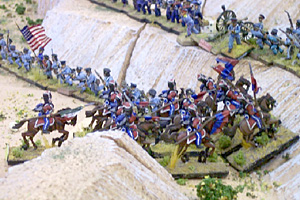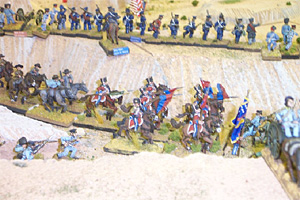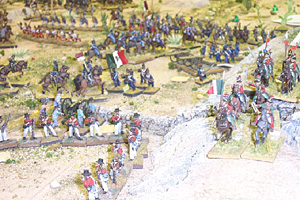 Once again into the breach dear friends. This time Chuck’s Challenge, a special game for instigators present the Thursday night before the convention, was Bill Moreno’s epic representation of Buena Vista. We began with the U.S. forces deployed as they were at the beginning of the battle. Santa Anna’s troops, after a hard march through northern Mexico, were emerging in columns up the pass. Once Chuck had gone over the Mexicans I got to be Zachary Taylor. Something about how I was the only U.S. player with gray hair. Rickey Grice pitched in as General Wool. The rules were LTC John “Buck” Surdu’s SANTA ANNA RULES. Most of us were able to approach these rules without prejudice. Or perhaps in complete ignorance would be a more accurate description.
Once again into the breach dear friends. This time Chuck’s Challenge, a special game for instigators present the Thursday night before the convention, was Bill Moreno’s epic representation of Buena Vista. We began with the U.S. forces deployed as they were at the beginning of the battle. Santa Anna’s troops, after a hard march through northern Mexico, were emerging in columns up the pass. Once Chuck had gone over the Mexicans I got to be Zachary Taylor. Something about how I was the only U.S. player with gray hair. Rickey Grice pitched in as General Wool. The rules were LTC John “Buck” Surdu’s SANTA ANNA RULES. Most of us were able to approach these rules without prejudice. Or perhaps in complete ignorance would be a more accurate description.
Mexican Hussar Guard’s Death or Glory Charge against the 1st Illinois Volunteers
The U.S. initial disposition was a bit complicated. There were two ridges about 4’ apart, representing an uncertain distance somewhat in excess of maximum cannon range. The plain was occupied by a motley collection of horsemen. Regular dragoons who were well trained and mounted, Texas volunteer cavalry loaded down with state of the art ordinance (revolvers, sawed off shotguns, etc.) and some down at the heels Arkansas and Kentucky volunteers of uncertain armament and inclination. The bulk of the infantry, volunteers all, were along the north ridge. The unit most distant from the mass of Mexicans (many of whom never got onto the tactical board) were the famous Mississippi Rifles under Colonel Jefferson Davis. Across the plain was a stone wall, and with the cavalry a 6pdr battery of what was termed “flying artillery.” Using an 18” command radius, General Wool and I were supposed to pull the troops together and resist the onslaught of the Mexican hordes.
Of course we had other commanders on both sides. But, perhaps affected by the 3am conclusion of Chuck’s Challenge I, as well as the effort of reaching the convention across storm ravaged terrain, there were several early defections. But we worked out a plan. I really wanted to line the stone wall with infantry (not available) and the 6pdr, with the other two batteries falling back to anchor on the north ridge. Somehow I didn’t think cavalry should be wasted charging masses of conscripted peasants. Converging fire. Steady infantry. Use the horses for feints and exploitations. But this was not to be.
For one thing, Chuck and our webmaster Greg Lukomski had a more dashing view of the role of mounted troops. In particular, Chuck located the fanciest regiment on the board, the celebrated Hussars del Protector de las Energias Supremas. Naturally being hussars they were natty dressers. And guards to boot! Chuck sent them charging off at the handiest U.S. unit.
Of course the withdrawing Arkansas horse militia were headed for the same spot, and the object of the charge, the 1st Illinois Volunteers, were posted at the top of a rough incline (-2 D6 on the move.) But off they went! Much to my surprise they thundered down a valley and up the hill-breaking the volunteers in fine style! Then they pursued the scattering infantry down another valley. It was magnificent-but perhaps not war. In another turn or two the Arkansas horse militia fell on their rear, and the Hoosiers rallied. After a glorious adventure the remnants of the prettiest regiment on the field departed for parts unknown.
 To the left, Arkansas Volunteer Cavalry, center, Hussars of the Whatever, right Illinois fugitives. Left foreground, smarter fugitives.
To the left, Arkansas Volunteer Cavalry, center, Hussars of the Whatever, right Illinois fugitives. Left foreground, smarter fugitives.
Unfortunately to get things sorted out Zachary Taylor had to gallop to the front, leaving Jeff Davis without adult supervision. Naturally I expected a regiment with such a colonel to move to the sound of the guns. Naturally they developed a fondness for suburban Buena Vista. One result of “Halt.” Another of “Do what they did last time.” This could kill Jeff Davis’s chances of becoming Secretary of War-let alone President of the Confederate States of America.
Greg’s charge, if it could be called such, was less effective than Chuck’s. The splendidly painted Mexican troopers went down the valley of death in single file and into a deeply formed 2nd Indiana Volunteer Regiment. A quick volley, a hedge of bayonets, and we saw no more of them. But the U.S. horsemen in the center were being drawn into just the sort of actions I had wanted to spare them (I’ve always been fond of horses.) The infantry (including Davis’s malingering Mississippians) were a long way from the stone wall. And the 6pdr firing from the wall wasn’t hitting anything! Tim Harwood handled the cannon and much of the center cavalry. Dr. Mark Stevens of Mississippi brought on the Mexican infantry while Chuck and Greg buckled where they should have swashed with the mounted arm.
To save the situation I launched one of the precious Dragoon units against a battalion of Mark’s Mexicans who were about to take the guns. They formed square and held, but the 6pdr finally got down to business and at the end of the first round of melee the hapless battalion was down to 5 figures. The other U.S. cavalry charges in the center were bogging down against lancers and militia, and the Granaderos Gardias Potestas Supremas were locked in battle (seeming to get the worst of it) with the U.S. left. Lancers had gone over the wall, and the Mississippi Rifles, finally set in motion by a galloping Zachary Taylor, were racing to plug the gap.
It was popularly judged that the U.S. right flank was in trouble, but the left, commanded by Rickey Grice (the Devil of Devil’s Wind) was holding solidly. There stood Wool like a stone wall. For all that, we accepted the consensus that the U.S. forces had the worst of a draw. I should say in our defense that in the real battle Taylor hung on grimly. But since Santa Anna’s plan was to knock out the small northern army before turning on Scott’s main force, it was a strategic defeat. And unless I am remembering wrong (happens to us old folks from time to time) the historical U.S. position was substantially the part Rickey held for the duration.
After studying a short account of the real battle (Dupuy’s ENCYCLOPEDIA OF MILITARY HISTORY) my impression was confirmed. It was apparently Braxton Bragg’s battery that started on the far side of the plain. Washington’s and Sherman’s east of the road. Probably the sensible thing for me to do as Zachary Taylor was to pull back and hold the high ground that corresponded to the Central and Northern Plateaus of the real battle. But where would I have put all those horsemen?
 At the end the U.S. forces found themselves on the side where Rickey, as General Wool, was holding his ground. In fact, the real battle was if anything more confusing than the miniature battle. To this day some Mexicans believe that had Santa Anna continued the fight for a second day he would could have broken the exhausted U.S. forces. The situation has been compared to McClellan’s position at Antietam. But, having had a good game, with no clear decision in sight, we U.S. players were the ones prepared to accept a marginal defeat rather than repeat the 3am donnybrook of Chuck’s Challenge I. We withdrew to the North and Central Plateau around 1am.
At the end the U.S. forces found themselves on the side where Rickey, as General Wool, was holding his ground. In fact, the real battle was if anything more confusing than the miniature battle. To this day some Mexicans believe that had Santa Anna continued the fight for a second day he would could have broken the exhausted U.S. forces. The situation has been compared to McClellan’s position at Antietam. But, having had a good game, with no clear decision in sight, we U.S. players were the ones prepared to accept a marginal defeat rather than repeat the 3am donnybrook of Chuck’s Challenge I. We withdrew to the North and Central Plateau around 1am.
The Mississippi Rifles belatedly reach the right flank. The handful grouped around the Mexican flag before the 6pdr are remnants of a square that stopped the U.S. Dragoons, and the lancers on the right cross the wall and ride for the U.S. rear areas (where they will be out of command and control for the duration.) Meanwhile the main Mexican forces in the background (and off onto the next table) push inexorably forward.
Back to Rebel Yell No. 28 Table of Contents
Back to Rebel Yell List of Issues
Back to Master Magazine List
© Copyright 2004 by HMGS South
This article appears in MagWeb.com (Magazine Web) on the Internet World Wide Web.
Other articles from military history and related magazines are available at http://www.magweb.com